- Joined
- Feb 2, 2011
- Messages
- 2,093
NEW RELEASES FOR OCTOBER 2023
THE EIGHTEENTH CENTURY COLLECTION
THE AMERICAN WAR OF INDEPENDENCE 1775 – 1783
THE BATTLE OF COWPENS, JANUARY 17[SUP]th[/SUP], 1781.
The Battle of Cowpens was an engagement during the American Revolutionary War fought on January 17[SUP]th[/SUP] 1781, near the town of Cowpens, South Carolina, between American forces under Brigadier General Daniel Morgan, and British forces under Lieutenant Colonel Banastre Tarleton, as part of the campaign in the Carolinas.
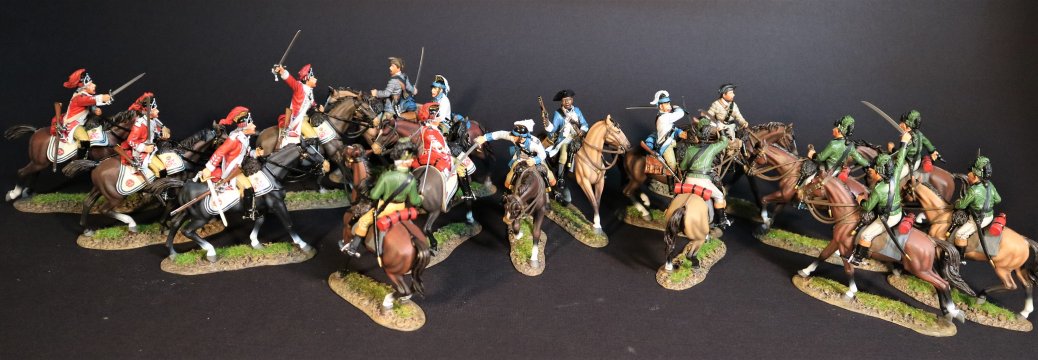
The battle was a turning point in the American reconquest of South Carolina from the British.
Tarleton’s force of 1,000 British troops were set against 2,000 troops under Morgan. Morgan’s forces suffered casualties of only 25 killed and 124 wounded. Tarleton’s force was almost completely eliminated with almost 30% casualties and 55% of his force captured or missing, with Tarleton himself and only about 200 British troops escaping.
Morgan’s forces conducted a double envelopment of the British forces, the only double envelopment of the war.
THE BRITISH LEGION
The British Legion was a British provincial regiment established during the American Revolutionary War, composed of British loyalist American infantry and dragoons. It was known as Tarleton’s Raiders after the British officer who led most of its day to day activities, Lieutenant Colonel Banastre Tarleton, and the green uniform coats. It was an unit the size of a regiment consisting of infantry, cavalry, and artillery, and able to operate independently.
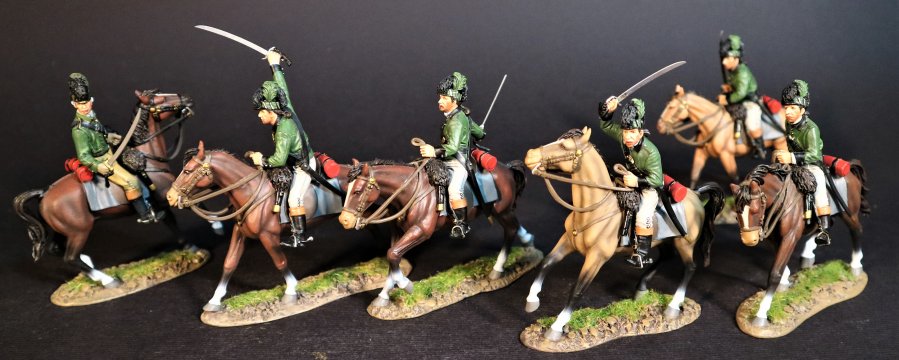
The unit was raised in New York in July 1778 by Sir Henry Clinton in order to merge combined infantry and cavalry forces and a battery of light artillery.
The regiment was commanded by William Lord Cathcart, as colonel.
Once the unit left New York, Banastre Tarleton was commissioned as Lieutenant colonel, and took full operational command.
The Legion’s peak operational strength was approximately 250 cavalry and 200 infantry.
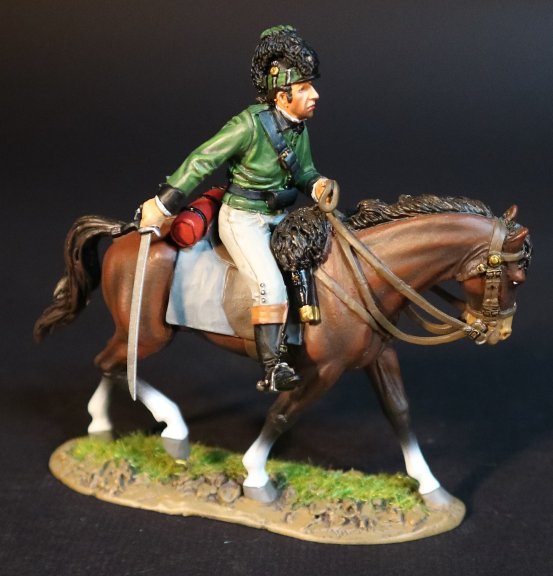
CWBL-02
THE AMERICAN WAR OF INDEPENDENCE 1775 – 1783
THE BATTLE OF COWPENS, JANUARY 17[SUP]th[/SUP], 1781.
THE BRITISH LEGION – “TARLETON’S RAIDERS”,
TROOPER.
(2 pcs)
THE 71[SUP]st[/SUP] REGIMENT OF FOOT
The Battle of Cowpens was an engagement during the American Revolutionary War fought on January 17[SUP]th[/SUP] 1781, near the town of Cowpens, South Carolina, between American forces under Brigadier General Daniel Morgan, and British forces under Lieutenant Colonel Banastre Tarleton, as part of the campaign in the Carolinas.
The battle was a turning point in the American reconquest of South Carolina from the British.
Tarleton’s force of 1,000 British troops were set against 2,000 troops under Morgan. Morgan’s forces suffered casualties of only 25 killed and 124 wounded. Tarleton’s force was almost completely eliminated with almost 30% casualties and 55% of his force captured or missing, with Tarleton himself and only about 200 British troops escaping.
Morgan’s forces conducted a double envelopment of the British forces, the only double envelopment of the war.
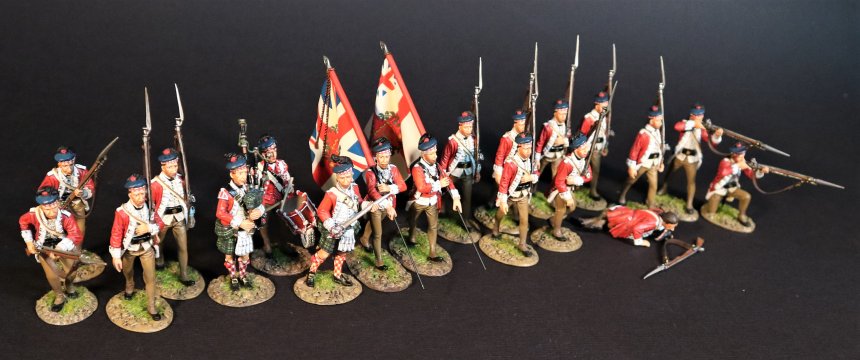
The 71[SUP]st[/SUP] Regiment of Foot was a regiment of infantry raised in 1775, and unofficially known as Fraser’s Highlanders. It was disbanded in 1786.
The regiment was raised at Inverness, Stirling and Glasgow by Lieutenant- General Simon Fraser of Lovat as the 71[SUP]st[/SUP] Regiment of Foot in 1775.
It was specifically intended for service in the American Revolutionary War.
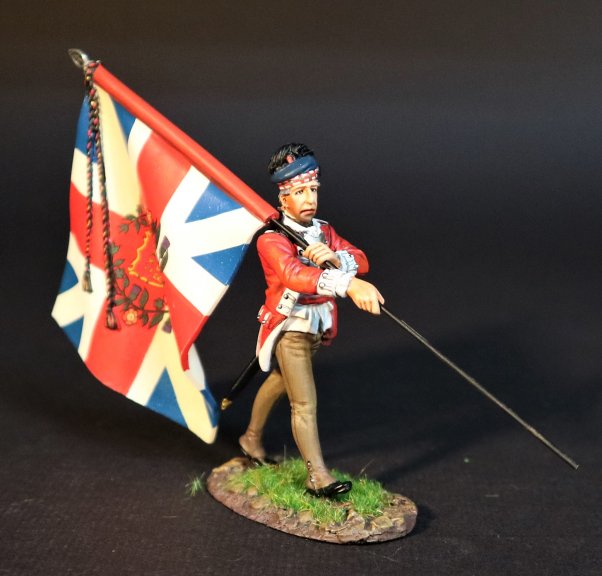
CW71-09
THE AMERICAN WAR OF INDEPENDENCE 1775 – 1783
THE BATTLE OF COWPENS, JANUARY 17[SUP]th[/SUP], 1781.
THE BRITISH ARMY,
1[SUP]st[/SUP] BATTALION, 71[SUP]st[/SUP] REGIMENT OF FOOT.
STANDARD BEARER.
(2 pcs)
After service in the northern colonies, the regiment was sent south in December 1778. From that time forward all parts of the regiment were involved in most actions of the southern campaign. The 71[SUP]st[/SUP] was to incorporate numerous colonial recruits, though the morale of the unit as a regular regiment was high.
The 1[SUP]st[/SUP] Battalion under Major Archibald McArthur was assigned to Tarleton’s command to pursue Daniel Morgan’s Flying army until the clash at Cowpens. The only men to escape the Cowpens debacle were those few left guarding the baggage train in the rear. As a result of the defeat the regiment thereafter wore no uniform facings. The officers of the 71[SUP]st[/SUP] petitioned Cornwallis that the regiment never again serve under Tarleton’s command, and Cornwallis honoured the request.
The remnants of the 71[SUP]st[/SUP] would fight on, and surrendered at Yorktowm.
THE QUEEN’S RANGERS (1[SUP]st[/SUP] AMERICAN REGIMENT) 1778-1783
SIMCOE’S RANGERS
The Queen’s Rangers came into being when Robert Rogers was authorized to raise a “Corps of Provincials” on August 16[SUP]th[/SUP] 1776. Recruited originally from Loyalists in New York and Connecticut, its men were farmers and city dwellers with little military experience.
They were a Loyalist military unit and were named for Queen Charlotte, consort of George III. The Queen’s Rangers served as a light corps in the tradition of British Rangers during the war, operating on the flanks and in advance of Crown forces, manning outposts, conducting patrols, and carrying out reconnaissance and raiding operations.
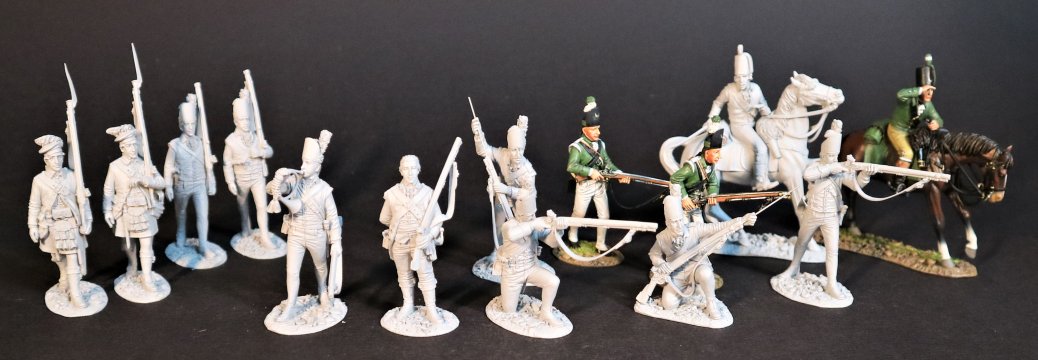
Following an inauspicious start when it was mauled by an American surprise attack at Mamaroneck in October 1776, it participated successfully in various campaigns throughout the Revolution until the surrender at Yorktown.
In a period of about a year, the Rangers had three commanding officers following Rogers. Major Christopher French reorganized the corps, during which process many officers and enlisted men were discharged. He was followed by Major James Wemyss in May 1777, under whom the unit increased in size and efficiency, participating in the Brunswick raid of June 1777. In the Battle of Brandywine, the command suffered the loss of one third of its number in killed or wounded, fourteen of twenty one commissioned officers were casualties.
Wemyss was wounded at the battle of Germantown. Major John Graves Simcoe succeeded him as commanding officer on October 15[SUP]th[/SUP], 1777.
It was under Simcoe that the Rangers reached the height of its efficiency. Starting as an infantry command, it gradually expanded and before its surrender at Yorktown consisted of eleven companies of foot, including riflemen, light infantry, grenadiers and a highland company, as well as dragoons, Hussars and some light guns.
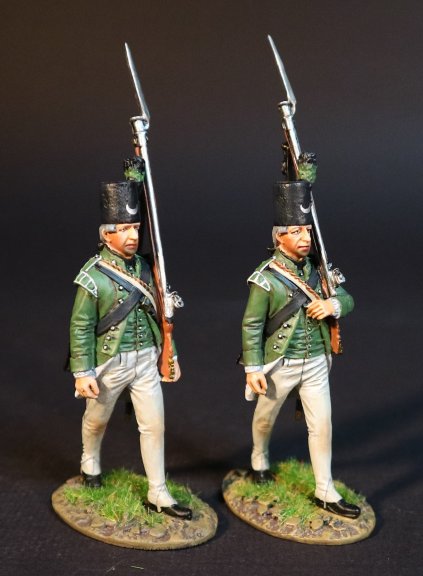
SQR-05
THE AMERICAN WAR OF INDEPENDENCE 1775 – 1783
THE BRITISH ARMY,
THE QUEEN’S RANGERS 1778-1783,
SIMCOE’S RANGERS,
GRENADIERS.
(2 pcs)
Simcoe had advanced ideas regarding training and discipline. He advocated costant vigilance, physical activity, and endurance of fatigue. There was constant instruction in marksmanship, the use of the bayonet, open formations, and the use of ambuscades. Units were trained to seldom return by their outgoing route. Officers were selected on their ability to perform such duties, and promotions when they occurred were from within the corps.
Regularity of messing and cleanliness were stressed, and officers were held responsible for the health of their men.
Written orders were avoided when possible, officers met after parade and received their orders verbally.
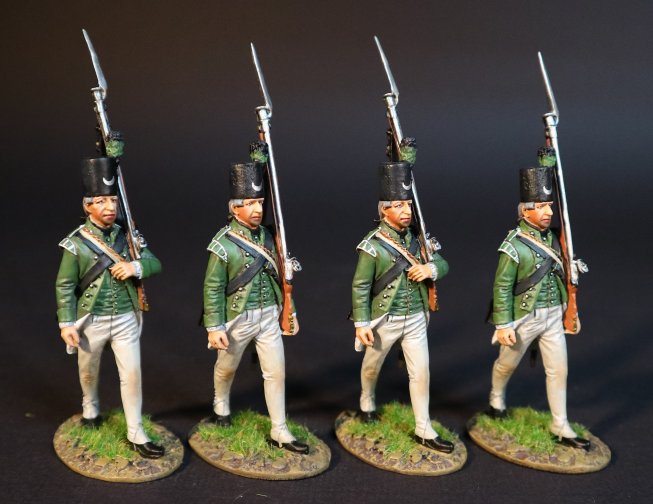
SQR-05N
THE AMERICAN WAR OF INDEPENDENCE 1775 – 1783
THE BRITISH ARMY,
THE QUEEN’S RANGERS 1778-1783,
SIMCOE’S RANGERS,
GRENADIERS.
(4 pcs)
After the war, the Rangers were removed to the British colony of Nova Scotia and disbanded.
**PLEASE CONTACT YOUR LOCAL DEALER FOR FURTHER INFORMATION**
THE EIGHTEENTH CENTURY COLLECTION
THE AMERICAN WAR OF INDEPENDENCE 1775 – 1783
THE BATTLE OF COWPENS, JANUARY 17[SUP]th[/SUP], 1781.
The Battle of Cowpens was an engagement during the American Revolutionary War fought on January 17[SUP]th[/SUP] 1781, near the town of Cowpens, South Carolina, between American forces under Brigadier General Daniel Morgan, and British forces under Lieutenant Colonel Banastre Tarleton, as part of the campaign in the Carolinas.

The battle was a turning point in the American reconquest of South Carolina from the British.
Tarleton’s force of 1,000 British troops were set against 2,000 troops under Morgan. Morgan’s forces suffered casualties of only 25 killed and 124 wounded. Tarleton’s force was almost completely eliminated with almost 30% casualties and 55% of his force captured or missing, with Tarleton himself and only about 200 British troops escaping.
Morgan’s forces conducted a double envelopment of the British forces, the only double envelopment of the war.
THE BRITISH LEGION
The British Legion was a British provincial regiment established during the American Revolutionary War, composed of British loyalist American infantry and dragoons. It was known as Tarleton’s Raiders after the British officer who led most of its day to day activities, Lieutenant Colonel Banastre Tarleton, and the green uniform coats. It was an unit the size of a regiment consisting of infantry, cavalry, and artillery, and able to operate independently.

The unit was raised in New York in July 1778 by Sir Henry Clinton in order to merge combined infantry and cavalry forces and a battery of light artillery.
The regiment was commanded by William Lord Cathcart, as colonel.
Once the unit left New York, Banastre Tarleton was commissioned as Lieutenant colonel, and took full operational command.
The Legion’s peak operational strength was approximately 250 cavalry and 200 infantry.

CWBL-02
THE AMERICAN WAR OF INDEPENDENCE 1775 – 1783
THE BATTLE OF COWPENS, JANUARY 17[SUP]th[/SUP], 1781.
THE BRITISH LEGION – “TARLETON’S RAIDERS”,
TROOPER.
(2 pcs)
THE 71[SUP]st[/SUP] REGIMENT OF FOOT
The Battle of Cowpens was an engagement during the American Revolutionary War fought on January 17[SUP]th[/SUP] 1781, near the town of Cowpens, South Carolina, between American forces under Brigadier General Daniel Morgan, and British forces under Lieutenant Colonel Banastre Tarleton, as part of the campaign in the Carolinas.
The battle was a turning point in the American reconquest of South Carolina from the British.
Tarleton’s force of 1,000 British troops were set against 2,000 troops under Morgan. Morgan’s forces suffered casualties of only 25 killed and 124 wounded. Tarleton’s force was almost completely eliminated with almost 30% casualties and 55% of his force captured or missing, with Tarleton himself and only about 200 British troops escaping.
Morgan’s forces conducted a double envelopment of the British forces, the only double envelopment of the war.

The 71[SUP]st[/SUP] Regiment of Foot was a regiment of infantry raised in 1775, and unofficially known as Fraser’s Highlanders. It was disbanded in 1786.
The regiment was raised at Inverness, Stirling and Glasgow by Lieutenant- General Simon Fraser of Lovat as the 71[SUP]st[/SUP] Regiment of Foot in 1775.
It was specifically intended for service in the American Revolutionary War.

CW71-09
THE AMERICAN WAR OF INDEPENDENCE 1775 – 1783
THE BATTLE OF COWPENS, JANUARY 17[SUP]th[/SUP], 1781.
THE BRITISH ARMY,
1[SUP]st[/SUP] BATTALION, 71[SUP]st[/SUP] REGIMENT OF FOOT.
STANDARD BEARER.
(2 pcs)
After service in the northern colonies, the regiment was sent south in December 1778. From that time forward all parts of the regiment were involved in most actions of the southern campaign. The 71[SUP]st[/SUP] was to incorporate numerous colonial recruits, though the morale of the unit as a regular regiment was high.
The 1[SUP]st[/SUP] Battalion under Major Archibald McArthur was assigned to Tarleton’s command to pursue Daniel Morgan’s Flying army until the clash at Cowpens. The only men to escape the Cowpens debacle were those few left guarding the baggage train in the rear. As a result of the defeat the regiment thereafter wore no uniform facings. The officers of the 71[SUP]st[/SUP] petitioned Cornwallis that the regiment never again serve under Tarleton’s command, and Cornwallis honoured the request.
The remnants of the 71[SUP]st[/SUP] would fight on, and surrendered at Yorktowm.
THE QUEEN’S RANGERS (1[SUP]st[/SUP] AMERICAN REGIMENT) 1778-1783
SIMCOE’S RANGERS
The Queen’s Rangers came into being when Robert Rogers was authorized to raise a “Corps of Provincials” on August 16[SUP]th[/SUP] 1776. Recruited originally from Loyalists in New York and Connecticut, its men were farmers and city dwellers with little military experience.
They were a Loyalist military unit and were named for Queen Charlotte, consort of George III. The Queen’s Rangers served as a light corps in the tradition of British Rangers during the war, operating on the flanks and in advance of Crown forces, manning outposts, conducting patrols, and carrying out reconnaissance and raiding operations.

Following an inauspicious start when it was mauled by an American surprise attack at Mamaroneck in October 1776, it participated successfully in various campaigns throughout the Revolution until the surrender at Yorktown.
In a period of about a year, the Rangers had three commanding officers following Rogers. Major Christopher French reorganized the corps, during which process many officers and enlisted men were discharged. He was followed by Major James Wemyss in May 1777, under whom the unit increased in size and efficiency, participating in the Brunswick raid of June 1777. In the Battle of Brandywine, the command suffered the loss of one third of its number in killed or wounded, fourteen of twenty one commissioned officers were casualties.
Wemyss was wounded at the battle of Germantown. Major John Graves Simcoe succeeded him as commanding officer on October 15[SUP]th[/SUP], 1777.
It was under Simcoe that the Rangers reached the height of its efficiency. Starting as an infantry command, it gradually expanded and before its surrender at Yorktown consisted of eleven companies of foot, including riflemen, light infantry, grenadiers and a highland company, as well as dragoons, Hussars and some light guns.

SQR-05
THE AMERICAN WAR OF INDEPENDENCE 1775 – 1783
THE BRITISH ARMY,
THE QUEEN’S RANGERS 1778-1783,
SIMCOE’S RANGERS,
GRENADIERS.
(2 pcs)
Simcoe had advanced ideas regarding training and discipline. He advocated costant vigilance, physical activity, and endurance of fatigue. There was constant instruction in marksmanship, the use of the bayonet, open formations, and the use of ambuscades. Units were trained to seldom return by their outgoing route. Officers were selected on their ability to perform such duties, and promotions when they occurred were from within the corps.
Regularity of messing and cleanliness were stressed, and officers were held responsible for the health of their men.
Written orders were avoided when possible, officers met after parade and received their orders verbally.

SQR-05N
THE AMERICAN WAR OF INDEPENDENCE 1775 – 1783
THE BRITISH ARMY,
THE QUEEN’S RANGERS 1778-1783,
SIMCOE’S RANGERS,
GRENADIERS.
(4 pcs)
After the war, the Rangers were removed to the British colony of Nova Scotia and disbanded.
**PLEASE CONTACT YOUR LOCAL DEALER FOR FURTHER INFORMATION**

